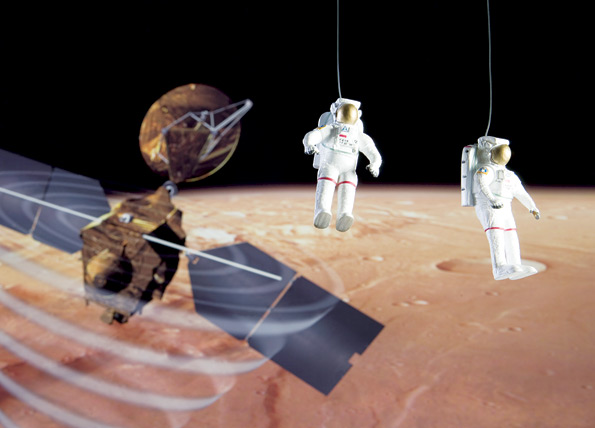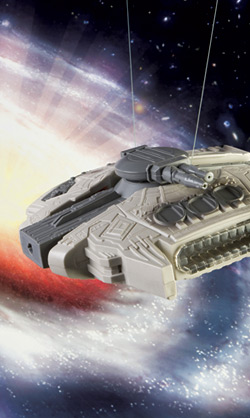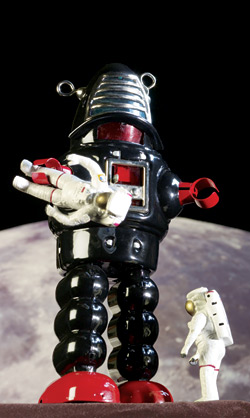The wrong stuff
When bad physics pop up in a movie or TV show, scientists try to set things right.
By Amelia Williamson
 |
| Photo-illustrations: Reidar Hahn and Fred Ullrich, Fermilab |
Physicist Brian Cox has been watching science fiction movies since he was a small child. He always scoffed at the imprecise nature of the science in movies. But over the past year, he learned a lot about the balance between making a movie entertaining and making it scientifically correct.
Cox worked closely with Danny Boyle, director of the movie Sunshine, to ensure that the science in the movie was as respectable as possible. “I was pretty pedantic about science fiction before I worked on Sunshine,” Cox says. “I learned about the compromises that have to be made in order to make a movie an emotional journey, rather than just a documentary.”
Sunshine is set 50 years in the future. The sun is dying and is no longer providing the energy that humans need to survive. The global community pulls together to send a team of eight scientists on a mission to reignite the dying sun with a bomb the size of Manhattan. The first group of scientists sent on the mission had failed, and this second team is Earth’s only hope. On their way to the sun, the scientists find the wrecked ship from the previous mission and decide to pick up its bomb to double their chances of succeeding.
The premise of the film seems preposterous. While the sun, like other stars, will eventually burn out, scientists calculate that this will take about four to five billion years. If it did burn out, how could a bomb—even one the size of Manhattan—reignite it?
Theoretically, all this could happen, Cox says in a Q&A posted on the movie’s Web site. He helped come up with a back story, not explained in the movie, in which a hypothetical type of atomic nucleus called a Q ball hits the sun and rips its atoms apart, turning them into particles called squarks.
As for the bomb, it would use uranium to trigger dark matter, which is thought to make up a large fraction of the universe. This would create enough heat to split the Q balls apart.
This scenario assumes that a number of unverified theories are, in fact, correct, Cox says. Even if the theories were correct, Q balls might pass through the sun without stopping, or destroy it at a much slower rate than shown in the movie.
Within the movie’s science-fiction framework, the director wanted the scientists to be as authentic as possible. He contacted Cox after seeing the young Manchester University physicist on one of the BBC’s Horizon shows, and asked him to teach the actors how to act like physicists. Cox works at CERN, the European particle physics lab in Switzerland.
 |
Tweaking the science
Cox is one of a number of scientist consultants who work to make movies and TV shows as scientifically accurate as possible.
To meet the growing demand, Lizzie Burns co-founded Hollywood Math and Science Film Consulting in 2002. The company has worked on TV shows such as Medium and Numb3rs as well as movies such as Flatland: The Movie and Primer.
Burns says the most important thing is for a movie to be entertaining. “Our aim as science consultants is always to help produce a good and enjoyable film or television program,” she says. “But if the science is obviously wrong, it takes away from the film. Avoiding obvious mistakes is an important part of keeping the fantasy believable.”
The firm’s seven consultants review scripts and make sure plot ideas are plausible. They also flag any science mistakes and suggest ideas for story lines. “We can give advice,” Burns says, “but it’s always up to the producers to decide how much of it they incorporate into the film or program.”
For instance, for an episode of the TV show Medium involving a mentally unstable mathematician who is fighting terrorists, the firm provided math images to decorate his apartment, complex equations for a voice-over, and lines from a paper on coding theory.
Jonathan Farley, a mathematician who co-founded the firm, says producers may not incorporate every suggestion into the script, but do revise scenes to reflect some of them.
“We try to make it so the science is not laughable,” he says, “and we try to provide ideas to incorporate into the script to help the producers obtain whatever their goals might be.”
Walk like a physicist
As part of his work on Sunshine, Cox held several science mini-lectures for the actors on physics and astronomy topics, as well as a two-week “science boot camp.” He spent a lot of time in particular with actor Cillian Murphy, who played physicist Robert Capa. They spent a day together at CERN attending physics meetings and talking with physicists. “The director told Cillian to pay close attention to the way I talk and how I respond as a scientist,” Cox says. Murphy noticed that Cox uses his hands a lot when talking about science, and incorporated that into his character. Murphy also hung one of Cox’s physics papers in Capa’s quarters on the set to make the scenes there feel more real.
Cox also helped remove “scientific babble” from the script and made sure there were no obvious mistakes. Boyle made it clear from the beginning, however, that he was not making a $50 million documentary, and that some things in the movie would not be scientifically correct. Some imprecision and compromises are necessary for the drama in movies, and people need to look past the small science inaccuracies to see the broader message, Cox says. “Sunshine isn’t really a film about science,” he explains. “It’s about scientists and the way they look at the world. That’s what the director really wanted to get right.”
Cox says he is happy with the final product. “It’s a very beautiful film,” he says. “As a scientist, it helps me connect with those things about nature that I find interesting and reminds me of why I wanted to be a scientist in the first place.”
He adds that he also learned a lot about the art of communicating science to the public. “Just giving facts to people doesn’t work—they don’t respond to facts,” he says. “In communicating science, we have to learn to connect with people in the way they’re used to interacting, and that requires emotional language, not scientific language.”
 |
Cherished misconceptions
Films have been plagued with bad science from the start. The first science fiction film ever made, A Trip to the Moon, which came out in 1902, featured astronomers who fly into space in a capsule shot out of a cannon, hit the man in the moon in the eye, and are chased by moon creatures, escaping by pushing the capsule off the moon’s flat edge.
Viewers accept and even expect some science inaccuracies. For example, audiences tend to be disappointed when explosions in space don’t make noise, so producers usually leave the noise in, even though sound cannot travel through the vacuum of space. In most movies and television shows, people in spacecraft are not weightless. There are two main reasons for this, according to Cox. First, reproducing weightlessness is very expensive; second, it distracts from the plot. “In a drama, viewers should be watching the actors’ performances and listening to their dialogue,” Cox says. “But when things are upside down or floating around, it’s harder to pay attention to the plot.”
Some movies are so inaccurate, however, that they seem to create their own laws of physics.
Tom Rogers, a high school physics teacher in South Carolina, created the Insultingly Stupid Movie Physics Web site in 1996. “Sometimes when I watch movies, some of the silly science stuff just drives me wild,” Rogers says. “Really what it boils down to is that movie makers have developed a whole set of visual clichés that they use” to represent science, although recently they’ve been making more of an effort to get things right.
Among the classic physics mistakes he cites: Gunfire with bright flashing bullets, cars that explode in fiery collisions, and visible laser beams. Movie heroes fall from great heights with no significant injuries and crash through plate glass windows without a scratch. And who can forget movies in which people or other creatures are shrunk or expanded to many times their original size? In reality, people blown up to 100 times normal size would have such low densities that they would float away like balloons, while people shrunk to 1/100th size would become so dense they would sink through concrete sidewalks.
The Web site rates movies according to their scientific accuracy. Road to Perdition and Al Gore’s An Inconvenient Truth were rated GP, for “good physics,” while Planet of the Apes, Armageddon, and the new Star Wars movies were rated XP (“physics from an unknown universe”).
Documentaries with verve
People who make science documentaries have the opposite concern—how to catch and hold the viewer’s interest, says Paula Apsell, senior executive producer of PBS’s NOVA series.
“The most important thing is to be a good storyteller,” she says. “It’s always a complex stance between what your story is, the characters you develop to tell it, and the information that you feel is important to present.”
The producers of NOVA do not hire science consultants, but they do ask scientists for advice—first as the program is being researched, and again when the script is finished. “We have to make sure the show is accessible to a general audience, but at the same time we have to make sure that the scientific information presented is correct and not dumbed down,” Apsell says.
She adds that while the media are powerful tools to communicate science, they can also spread misunderstanding and stereotypes. “If you’re not careful, you can convey a very misleading idea of what science is,” Apsell says. “Dramatic programs should have dramatic license, but they cross the line when they confuse science and pseudoscience and when they fuel negative stereotypes of science and scientists.”
Properly handled, though, science and drama can be a good mix.
“You have to understand that attention to detail is what science is all about,” says Cox. “But in communicating science—why it’s interesting and why people should find scientific discoveries incredible and exciting—the details don’t matter as much. Instead, we need to paint broader pictures and use metaphors. That’s the way forward.”
Click here to download the pdf version of this article.






